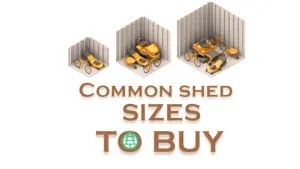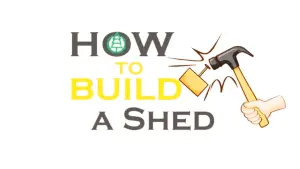What Size of Shed Should I Buy?
- July 7, 2023
- 0 comment
Choosing the perfect shed for your needs is a bit like buying clothes. Just as you wouldn’t buy a shirt that’s too tight or too loose, you want a shed that fits your needs perfectly. Too small and you’ll quickly outgrow it. Too large, and you’ve wasted space and money. So, what size shed should you buy? Let’s explore this topic in detail.
1. Defining Your Needs
Understanding your needs is the foundation of choosing the right shed size. A shed can serve various purposes, and it’s important to clearly identify its primary function for you.

A. Storage Sheds
The most common use of a shed is for storage. Many homeowners use sheds to store garden tools, lawn care equipment, bicycles, and even seasonal decorations. If you’re in this category, you’ll want to inventory what you plan to store.
For smaller items, a compact shed of 6’x4′ or 8’x6′ might be sufficient. However, if you have larger equipment such as lawnmowers, motorbikes, or wheelbarrows, you’ll need to consider larger dimensions. For those with a lot of equipment or larger items, sheds of 10’x10′, 12’x8′, or larger can provide ample space.
B. Workshop or Office Sheds
If you intend to use your shed as a workshop or a home office, you’ll need to account for additional space. Workshops need enough room for workbenches, tools, and movement. Home offices require space for a desk, chairs, shelves, and other office equipment. In both cases, you also want to ensure enough room for comfortable circulation and task execution.
An office or workshop shed should ideally be at least 10’x10′, but depending on your specific needs, you may require a larger structure.
2. Consider Future Use

When defining your shed size, it’s not only about what you need right now but also what you might need in the future. Upgrading to larger gardening tools, starting new hobbies, or expanding your DIY endeavors are all scenarios where extra shed space might become necessary.
Giving yourself a bit of extra room for future growth can save you the inconvenience and expense of having to replace your shed prematurely. It’s a fine balance between meeting your current needs, preparing for future possibilities, and staying within your budget and space constraints.
3. Local Regulations and Restrictions

Never underestimate the importance of local regulations. Some councils or homeowner’s associations might have restrictions on the size of outbuildings or where they can be placed on your property. These can affect both the size and location of your shed.
Always check with relevant local authorities before finalizing your shed size. You might need to apply for a permit or comply with certain design standards. Being aware of these requirements can save you from headaches and potential penalties down the line.
By thoroughly defining your needs, considering future use, and understanding local regulations, you can ensure that the shed you choose is the perfect fit for your lifestyle, now and in the future.
4. Measuring Up
After you’ve identified the purpose of your shed and considered future usage, the next crucial step in the process is to “measure up.” This means taking into account the physical space in your yard where the shed will be located. Here’s how to ensure you get it right:

A. Selecting the Shed’s Location
First, determine where your shed is going to be located. Look for a spot that’s easily accessible, relatively level, and suitable for the size of shed you have in mind. Remember, the location you choose will need to accommodate not just the shed itself, but also allow for easy movement around it.
B. Allow for Clearance and Access
Consider the full scope of activities you’ll be undertaking around the shed. Will you be moving large items in and out? If so, is there ample room for doors to swing open without hitting anything? Additionally, consider how you’ll be getting to and from the shed. Do you need a clear path for wheeling a lawnmower or bike in and out?
As a rule of thumb, you should allow an extra two feet around the shed for clearance. This allows enough space to comfortably move around, open the doors fully, and access items without feeling cramped. It’s also beneficial if you need to carry out maintenance or repairs on the shed in the future.
C. Additional Landscaping
If you have plans for additional landscaping, such as planting a garden around the shed or adding a walkway leading to it, be sure to account for this extra space in your measurements.
Consider the mature size of any plants you’re thinking of adding, not just their size when you plant them. Also, if you’re planning a walkway, remember to leave enough room for it to be a comfortable width, and for you to be able to maintain the pathway and any bordering plants.
D. Measuring Tools and Techniques
When it’s time to take actual measurements, a tape measure is your best friend. Measure the area for your proposed shed location in both directions – length and width. Then, mark out the corners of your proposed shed using stakes and string. This can give you a visual idea of how much space the shed will take up.
To sum up, accurate measurement and mindful space planning are essential when installing a shed. It ensures that you maximize the utility of your shed while maintaining the aesthetics and accessibility of your yard. Remember, a little bit of extra time spent measuring and planning can save a lot of trouble in the future.
5. Height Matters, Too
While the length and width – the footprint – of your shed are critical considerations, it’s equally important to pay attention to the vertical dimension: the height. The height of your shed affects its storage capacity, usability, and even adherence to local building codes.

A. Storage of Tall Items
If you’re planning to store tall items in your shed, such as ladders, rakes, or kayaks, the height of the shed becomes an important factor. You’ll need to ensure that the shed’s peak and wall heights can comfortably accommodate these items.
Don’t forget to account for the door height too. A tall shed isn’t of much use if you can’t fit your tall items through the door. Double-check the door’s dimensions to ensure it’s wide and tall enough for your needs.
B. Installation of Shelves and Cabinets
Shelving and cabinets can significantly increase the storage capacity of your shed, making efficient use of the vertical space. If you plan to install these, consider their height and the clearance they’ll need.
You’ll also need to account for the items you plan to store on the shelves. Ensure there’s enough space between shelves to accommodate your items, and remember to consider ease of access – you don’t want to have to use a step stool every time you need your gardening gloves.
C. Workspace and Headroom
If your shed is going to serve as a workshop, studio, or office, the height is even more important. You’ll need adequate standing headroom. At a minimum, the interior height should be tall enough for the tallest person who will be using the shed to stand comfortably.
Moreover, the roof’s peak height could influence the feeling of spaciousness in the shed. A shed with a higher peak can feel more spacious and comfortable to work in. Depending on the style of the shed, the roof might also provide additional storage space.
6. Quality over Quantity
While size is a primary factor when selecting a shed, the quality of the shed is equally important. A high-quality shed is an investment that will serve you well over time, providing reliable storage or workspace while enhancing the aesthetics of your garden. Here are some key quality considerations to bear in mind.

A. Sturdy Construction
The structural integrity of your shed is paramount. The shed should be well-built and robust enough to withstand not just the weight of the items stored inside, but also the various environmental factors it will be subjected to. Sturdy construction comes from strong, durable materials, quality fasteners, and sound building techniques.
Check the sturdiness of the walls and the roof, and make sure the doors are well-hung and open smoothly. If the shed isn’t sturdy, it might not hold up well to heavy wind, snow loads, or the wear and tear of regular use.
B. Weather-Resistant Materials
Sheds are exposed to a variety of weather conditions – rain, sun, snow, and wind. To ensure the longevity of your shed, look for weather-resistant materials.
For instance, wooden sheds should ideally be made from treated lumber that’s resistant to rot and insect damage. Metal sheds should be rust-resistant, and plastic sheds should be UV-resistant to prevent them from cracking or fading in the sunlight.
Roofing materials should also be durable and capable of withstanding your local weather conditions. They need to provide adequate water shedding and insulation, especially if you plan to use your shed year-round.
C. Complementary Design
A shed isn’t just a functional addition to your property – it’s also an aesthetic one. The shed’s design should complement your home and garden’s style, seamlessly blending in with its surroundings.
Consider the style, color, and design details of the shed. Traditional sheds might work well in classic garden settings, while modern designs might suit more contemporary homes. If the shed is going to be a prominent feature in your garden, you might want to consider options like decorative doors, windows, or other design features that enhance its appearance.
Also, consider how the shed’s design might affect its usability. For instance, a shed with good natural lighting might be more enjoyable to use as a workspace. A shed with double doors could be more practical for storing large items.
Conclusion
When choosing a shed, consider not only your current needs but also future requirements, local regulations, and the physical space in your garden. Remember, it’s about finding the right size for your needs – not too big, not too small, but just right. And when in doubt, it’s always better to err on the side of a little extra space rather than too little. After all, it’s better to have room to grow than to outgrow your shed too soon.
So, what size shed should you buy? That, my friend, is a decision unique to you and your needs. Happy shed shopping!






Leave your comment